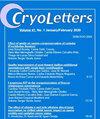基于替代冷冻保护剂的植物新材料低温保存方案的统一原则和系统方法。
IF 1
4区 生物学
Q3 BIOLOGY
引用次数: 4
摘要
这篇综述解决了一个经常遇到的问题,即设计一个有效的冷冻保存程序来保存新的(以前没有冷冻保存过的)或困难的植物材料。这个问题阻碍了世界范围内对野生植物和一些栽培植物的广泛遗传基础进行低温保存的努力。我们回顾了常规冷冻保护溶液(CPA)修改的最新进展,并提出了一种实用的方案开发方法,该方法包括植物组织的生理复杂性以及在CPA处理下的广泛行为。我们建议根据植物材料的大小、结构和对不同成分和浓度的CPA混合物所引起的渗透和化学胁迫的反应,包括替代渗透保护和玻璃化溶液,将营养植物材料分为四类。然后将针对每个类别专门设计的多达15个预设协议应用于材料。然后将最佳再生方案合并到优化程序中。与传统的“试错”低温保存方案相比,该系统的主要优点是测试所需的起始材料数量最少,并且通过相对较少的cpa处理提供了相对准确的低温保存应力下材料行为预测。该方法揭示的统一原则可以拓宽野生物种和材料的安全保存范围。预计还将把这种方法应用于具有生物技术价值的植物材料,以及对为其种类制定的标准方案反应不佳的农业和园艺作物品种。doi.org/10.54680/fr23110110112。本文章由计算机程序翻译,如有差异,请以英文原文为准。
Unifying principles of cryopreservation protocols for new plant materials based on alternative cryoprotective agents (cpas) and a systematic approach.
This review addresses a frequently encountered problem of designing an effective cryopreservation procedure for new (not previously cryopreserved) or difficult plant materials. This problem hinders worldwide efforts of applying cryopreservation across a wide genetic base of wild and a number of cultivated plants. We review recent advances in modifications of routinely applied cryoprotective solutions (CPAs) and suggest a practical approach to protocol development which embraces the physiological complexity of plant tissues as well as a wide spectrum of behaviours under CPA treatment. We suggest that vegetative plant materials are classified into four categories based on their size, structure, and the response to osmotic and chemical stresses provoked by CPA mixtures of varied composition and concentration, including alternative osmoprotection and vitrification solutions. A number of up to 15 preset protocols designed specifically for each category is then applied to the material. The protocols resulting in the best regrowth are then combined into the optimized procedure. The main advantage of this system over a conventional "trial-and-error" search for working cryopreservation protocol is a minimal amount of starting materials required for the tests and a relatively accurate prediction of material behaviour under cryopreservation stress provided by the relatively few CPAs treatments. The unifying principles revealed by this approach could broaden a spectrum of wild species and materials which can be safely conserved by cryopreservation. Also anticipated is application of this approach to plant materials of biotechnological value as well as cultivars of agricultural and horticultural crops which do not respond well to standard protocols developed for their kind. doi.org/10.54680/fr23110110112.
求助全文
通过发布文献求助,成功后即可免费获取论文全文。
去求助
来源期刊

Cryo letters
生物-生理学
CiteScore
1.80
自引率
10.00%
发文量
50
审稿时长
1 months
期刊介绍:
A bimonthly international journal for low temperature sciences, including cryobiology, cryopreservation or vitrification of cells and tissues, chemical and physical aspects of freezing and drying, and studies involving ecology of cold environments, and cold adaptation
The journal publishes original research reports, authoritative reviews, technical developments and commissioned book reviews of studies of the effects produced by low temperatures on a wide variety of scientific and technical processes, or those involving low temperature techniques in the investigation of physical, chemical, biological and ecological problems.
 求助内容:
求助内容: 应助结果提醒方式:
应助结果提醒方式:


